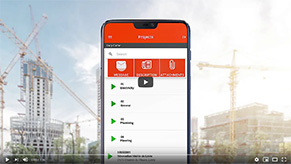
9 September, 2025
Mobile-Punch
SHARE
The 8 benefits of business communication tools
In a constantly evolving professional world, corporate communication tools have become essential for maintaining team cohesion and optimizing organizational performance. Whether you manage a field team in construction or supervise remote workers, these technological solutions are radically transforming the way we collaborate. Companies that invest in effective internal communication tools see noticeable improvements: reduced time spent on administrative tasks, smoother information flow, and increased overall productivity.
What is a corporate communication tool?
Definition and role of communication tools
A corporate communication tool refers to any technology or platform that facilitates the exchange of information between employees, teams, and different hierarchical levels. These digital solutions serve as a support for disseminating information, coordinating activities, and maintaining organizational cohesion. In today’s context of hybrid work and geographically dispersed teams, these tools are the core of internal communication strategies. They help create a connected work environment where information flows seamlessly, regardless of employees’ physical location.
The different types of available tools
The landscape of communication tools includes several distinct categories. Instant messaging and real-time communication platforms enable quick, informal exchanges between colleagues. Among the most widely used solutions are Slack, Microsoft Teams, Google Chat, and Zoom, which provide flexible, connected work environments. Project management solutions often include advanced collaborative features to coordinate teams. For companies with field teams, specialized solutions like Mobile-Punch offer features such as employee geolocation and mobile time tracking. These tools are tailored to the specific needs of sectors like construction, security, or maintenance, where mobility and data reliability are crucial. Document sharing platforms, company intranets, and online training tools complete this ecosystem by offering dedicated spaces for storing and sharing organizational knowledge.
The 8 main benefits of communication platforms
1. Significant productivity improvement
The most immediate impact of corporate communication tools is seen in the overall increase in productivity. Real-time information sharing eliminates traditional wait times and allows teams to make faster decisions. The centralization of essential information on a single platform drastically reduces time spent searching for documents or data. Employees can instantly access needed resources, whether it’s schedules, procedures, or project updates. This efficiency results in measurable gains: using an employee time tracking app helps optimize workdays and reduce repetitive administrative tasks.
2. Facilitating collaboration between teams
Communication tools break down organizational silos by creating shared workspaces where teams can collaborate effectively. Topic-based discussion groups, file-sharing spaces, and collaborative dashboards foster collective intelligence. Real-time project coordination becomes possible thanks to shared tracking features and automatic notifications. Team members can visualize task progress, identify potential blockers, and adjust priorities accordingly. For companies with geographically dispersed teams, these tools provide a clear view of each employee’s location and activities. This transparency strengthens mutual trust and improves operational coordination through features like digital work orders and geolocation.
Stronger engagement and corporate culture
3. Increased employee engagement
Research shows that regular and transparent internal communication improves employee engagement (source: Gallup, 2023). This correlation stems from the sense of inclusion and recognition these exchanges provide. Internal communication tools support systems for recognizing and valuing performance. Managers can share individual and team successes, create spaces for constructive feedback, and maintain ongoing dialogue with their teams. These platforms encourage two-way communication, allowing employees to express ideas, concerns, and suggestions. This active participation enhances their sense of belonging and motivation to contribute to organizational goals.
4. Strengthening company culture
Organizational culture is a key factor in employee retention. Collaborative tools play a vital role in building and maintaining this culture. Sharing common values and goals becomes more natural through dedicated communication spaces. Leaders can regularly share strategic messages, celebrate collective achievements, and keep everyone aligned with the company vision. For organizations with dispersed teams, these tools create a sense of belonging that transcends geographic barriers. Virtual rituals, shared celebrations, and informal exchanges help forge lasting bonds between employees.

Operational optimization and talent management
5. Improved employee experience
The employee experience is greatly enhanced by transparent information and personalized communication. Employees appreciate having easy access to relevant information and receiving messages tailored to their roles and responsibilities. Centralizing messages and documents on one platform simplifies daily work. No more tedious searches through inboxes or shared servers: everything is accessible from a single, intuitive entry point. This improvement leads to a more positive work environment where communication frustrations are significantly reduced. Employees can focus on their core tasks rather than technical or organizational issues.
6. Attracting and retaining talent
Labor market data shows that the vast majority of candidates prefer transparent communication over traditional salary benefits when choosing an employer. This trend highlights the strategic importance of communication tools in employer branding. The onboarding process is optimized with digital training paths and dedicated exchange spaces. New hires can quickly adopt the company culture and form connections with colleagues. The reduction in employee turnover is a direct financial benefit of investing in these technologies. Companies that maintain high-quality communication experience greater talent retention and lower recruitment costs.
Operational efficiency and change management
7. Real-time communication for field teams
Industries with field teams, such as construction, security, cleaning, and maintenance, particularly benefit from mobile communication tools. Automatic geolocation ensures reliable attendance data and simplifies intervention tracking. Online and offline accessibility meets the technical challenges of mobile work environments. Employees can clock in, view schedules, and receive instructions even in low-connectivity areas. Real-time project and budget tracking allows managers to maintain precise control over progress and resource allocation. This operational visibility improves decision-making and enhances project profitability.
8. Facilitating organizational change
Collaborative platforms are essential tools for supporting organizational transformation. They prepare teams for upcoming changes, explain challenges, and collect employee feedback. Employee management becomes more efficient with fast and reliable communication channels. Leaders can instantly share critical information and maintain team cohesion during difficult times. This adaptability eases the transition to new processes and reduces resistance to change. Informed and involved employees are more likely to embrace organizational evolution.
How to choose and implement your communication tools
Essential selection criteria
Choosing a corporate communication tool should be based on several key criteria. Data security is a non-negotiable prerequisite, especially in today’s regulatory environment. Ease of use and mobile accessibility largely determine user adoption rates. An intuitive interface and multi-device compatibility ensure optimal use by all employees, regardless of technical proficiency. Integration with existing payroll software (such as Acomba or QuickBooks, accounting management tools) avoids duplicate entries and ensures data consistency. This interoperability simplifies administrative processes and reduces the risk of errors.
Simplified comparison of popular tools
| Tool | Main strengths | Best for |
| Mobile-Punch | Geolocation, mobile time tracking, hour tracking | Field teams (construction, transport, etc.) |
| Slack | Seamless communication, many integrations | Creative and tech teams |
| Microsoft Teams | Office 365 integration, advanced video conferencing | Large companies and SMEs |
| Zoom | Ease of use, video quality | Frequent remote meetings |
Best implementation practices
Successful implementation relies on structured team training and a phased rollout approach. Involving employees in early testing phases helps identify specific needs and fine-tune the setup accordingly. Customizing the tool to match company culture fosters user adoption. Adapting the interface, workflows, and notifications to existing organizational habits makes the transition easier.
To maximize adoption of a new communication tool, consider:
- Involving pilot teams in testing before full deployment
- Training key users quickly so they become internal ambassadors
- Setting up responsive support during the first few weeks
Time tracking and measuring results help evaluate ROI and identify areas for improvement. Metrics such as usage rate, user satisfaction, and productivity gains guide future optimizations.
Frequently asked questions about corporate communication tools
What are the most effective internal communication tools?
The most effective internal communication tools combine instant messaging, project management, and mobile features. For companies with field teams, solutions like Mobile-Punch integrate geolocation and automated time tracking.
How to measure the ROI of communication tools?
Return on investment is measured through various indicators: administrative time savings, reduced data entry errors, improved employee satisfaction, and lower turnover. Companies usually see a positive return within 6 to 12 months after implementation.
What is the difference between internal and external communication?
Internal communication targets employees and teams within the organization, while external communication addresses clients, partners, and prospects. Internal communication platforms focus on operational efficiency, whereas external tools are geared toward branding and customer relations.
How to effectively train teams on new tools?
Effective training combines theory sessions, hands-on workshops, and personalized support. Identifying internal ambassadors and creating tailored user guides accelerate adoption. Responsive technical support during the initial weeks ensures a smooth transition.
Corporate communication tools are a strategic investment for any organization looking to boost performance and retain talent. Their positive impact on productivity, engagement, and company culture makes them essential levers in digital transformation. Choosing a solution tailored to sector-specific and organizational needs ensures a sustainable and measurable return on investment.






